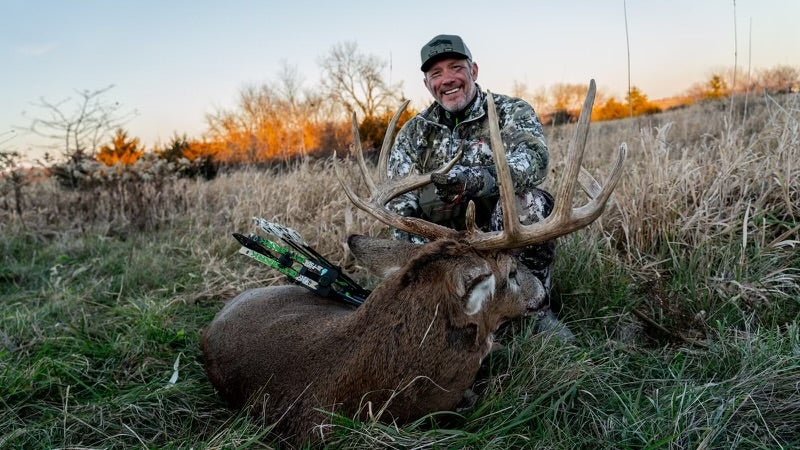John Dudley on How to Beat Buck Fever

When John Dudley was a kid, still learning how to hunt in Illinois, he had an encounter with a big buck that changed the trajectory of his bowhunting life. Dudley was hunting with a compound bow that was set too heavy—though he was able to draw the bow fine during practice.
When a stud buck casually walked into range, Dudley pulled with all of his might but he couldn’t get the bowstring back.
“He literally walks like 10 feet underneath my treestand … and I freakin’ pulled and tugged on that bow while my knees were clacking together,” Dudley says. “I had that thing pointed straight up in the air trying to pull it back. My heartbeat was hitting so hard I honestly thought I was going to need some stents or something by the time it was done.”
At first Dudley thought there was some sort of malfunction with his bow. As the buck walked off he examined the cams and the string. Then, with the deer (and the nerves) long gone, he simply grabbed the bow and drew it back without issue.
“You know when you have that nightmare that you can’t scream, well this was a living nightmare of John Dudley not being able to pull his bow back because he had buck fever that bad,” he says.
Fast forward a couple decades and Dudley is now an accomplished pro archer, a veteran whitetail hunter, and perhaps the most popular archery instructor in the country. Since that fateful Illinois bowhunt Dudley has learned a lot about shooting well under pressure during hunts and competitions. His hard-earned knowledge (which you can hear all about in the podcast episode below) will help you shoot your best when that big buck steps into your setup this fall.
Visualize a Perfect Shot
When Dudley is sitting in his treestand he visualizes all the good scenarios that he hopes will happen. But this is far more than daydreaming about a giant buck turning broadside. Just like an athlete preparing for all the motions of a game, he visualizes each specific movement he’ll make under each possible scenario.
“I visualize myself getting a couple good ranges on him [as the buck comes in],” Dudley says. “I visualize making sure I grab my release the right way. I’m pivoting my feet the right way. And [the buck] is doing his thing as I’m able to slowly draw. And then I think about my shot process.”
With all the waiting we do in a treestand, there’s plenty of time to visualize and plan for a variety of shot scenarios.
“Sometimes I’m in a stand for two weeks before I have an opportunity and I’m constructing these things in my mind,” Dudley says. “You literally end up creating a vision. And when that happens, your conscious mind is already thinking about all the processes [you need to execute].”
In other words, when that giant buck finally does show, you won’t feel shocked, because you’ve already visualized it hundreds or thousands of times.
Follow Your Shot Process
It’s almost a guarantee that every professional shooter in any shooting discipline has a shot process. As Dudley describes it, this is simply a series of words he says in his mind that coincide with actions he executes in order to make a perfect shot. Dudley’s shot process is this: 1) Stance; 2) Grip; 3) Shoulder; 4) Anchor; 5) Peep; 6) Pull and Finish.
Dudley learned the importance of having a process from Olympic medalist Lanny Bassham who wrote the book “With Winning in Mind” (which Dudley recommends for any shooter). The key is that saying the words and executing the movements is the work of the conscious mind. Activating the conscious mind helps prevent a shooter from “going on autopilot,” rushing the shot, punching the trigger, or simply blacking out.
You can and should adapt a shot process for your own needs. For example, OL gear editor and competitive archer Scott Einsmann’s process is: 1) Anchor; 2) Get it there (his cue to just get the aiming portion done with); 3) Feel alignment; 4) Okay, my shot can break anytime.
If you have a bad habit of getting excited and drawing back wildly, you might want to add a word like “smooth” to your shot process. If you have a tendency to get anxious about your pin floating around the target then you might want to add the word “float” to your process—reassuring yourself that it’s ok to let that pin float. The key is to have a shot process that works for you and to follow it on every single shot. Especially that shot on a giant buck.
Choose a Mantra
Reciting a mantra is similarly useful. Just like running through a shot process, a mantra gives control to your conscious mind. You must choose to say your mantra.
For competitions, Dudley’s mantra is: “I shoot Xs because they make me feel good.”
When an animal comes in during a hunting scenario Dudley says the word “checkmate” to himself.
“When the animal presents that shot … I’m thinking ‘checkmate’, you know, game over,” he says. “Because that’s a positive affirmation that really reinforces your conscious thought process rather than sitting there thinking ‘Oh man this is the biggest buck I’ve ever seen.’”
Get Used to Shooting Under Pressure
But these tactics don’t eliminate the excitement and subsequent pressure you’ll likely feel when you see a shooter buck. The real key is training yourself to get comfortable while shooting under pressure.
“Think of buck fever like a hot bathtub,” Dudley says. “It might be scalding hot when you first put your toe into it. But if you just breathe and ease into it, eventually you’re going to acclimate and that water is going to feel OK.”
This is why Dudley recommends shooting in archery tournaments so you can “put yourself in a situation where you feel like you’ve been in the boiling pot before.”
If you have a high deer population where you hunt, or you just need to fill the freezer, shooting a few does with your bow is also a great way to get used to shooting under pressure. Your potential case of buck fever will likely be less extreme if you’ve cleanly killed a few does earlier in the season.
On the flipside don’t crank up the pressure on yourself during a hunt. In the treestand you want to feel positive, confident, and mellow.
“Don’t apply self-induced pressure,” Dudley says. “That’s the only pressure you really have control over. Most of the time buck fever or target anticipation is from pressure that you’re applying to yourself. It’s not like the animal is shooting [pressure] up at you. The best thing you can do is just positive self affirmation.”
Practice How You Hunt
In the days leading up to a big deer hunt Dudley makes sure to get in some practice sessions from a seated position and from an elevated position. This is because most whitetail shots will be from a ground blind or a treestand.
It’s important to know that shooting downhill or shooting from a seated position will induce more pin movement while you’re holding on target. But that’s OK if you’re used to it.
“It’s about mentally getting over that [pin movement],” Dudley says.
But there’s also value in practicing at long range even if you won’t be shooting at long range during a hunt. This is because flaws in your shooting will be more apparent at longer distances, and recognizing those flaws will help you correct them.
“I actually practice more at 80 than any distance I shoot at,” Dudley says.
Dudley believes in Chuck Adam’s theory that your effective range as a bowhunter is half the distance of your effective range in the backyard. In other words, if you’re able to shoot 8-inch groups at 80 yards in the backyard, you’ll be able to shoot 8-inch groups at 40 yards under a hunting scenario.
Read Next: Best Broadheads for Deer
Plus, practicing at long range will boost your confidence when you move in for those realistic 20- and 30-yard shots. And really, at this point in the season, all practice is about building confidence for that moment of truth.
“Always practice at distances where you have confidence,” Dudley says. “Especially when you’re trying to instill confidence.”
The post John Dudley on How to Beat Buck Fever appeared first on Outdoor Life.
Articles may contain affiliate links which enable us to share in the revenue of any purchases made.
Source: https://www.outdoorlife.com/hunting/how-to-beat-buck-fever/





